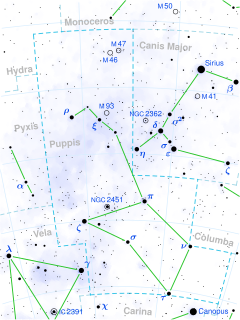See also
QW Puppis (I Puppis)
| This article includes a list of related items that share the same name (or similar names). If an internal link incorrectly led you here, you may wish to change the link to point directly to the intended article. |
The Bayer designations j Puppis and J Puppis are distinct. Due to technical limitations, both designations link here. For the star
A Bayer designation is a stellar designation in which a specific star is identified by a Greek or Latin letter followed by the genitive form of its parent constellation's Latin name. The original list of Bayer designations contained 1,564 stars.
QW Puppis (I Puppis)
| This article includes a list of related items that share the same name (or similar names). If an internal link incorrectly led you here, you may wish to change the link to point directly to the intended article. |

Argo Navis, or simply Argo, was a large constellation in the southern sky that has since been divided into the three constellations of Carina, Puppis and Vela. The genitive was "Argus Navis", abbreviated "Arg". Flamsteed and other early modern astronomers called the constellation just Navis, genitive "Navis", abbreviated "Nav".

Puppis is a constellation in the southern sky. Puppis, the Poop Deck, was originally part of an over-large constellation, the ship of "Jason and the Argonauts", Argo Navis, which centuries after its initial description was divided into three parts, the other two being Carina, and Vela. Puppis is the largest of the three constellations in square degrees. It is one of the 88 modern constellations recognized by the International Astronomical Union.
In astronomy, a variable star designation is a unique identifier given to variable stars. It uses a variation on the Bayer designation format, with an identifying label preceding the Latin genitive of the name of the constellation in which the star lies. See List of constellations for a list of constellations and the genitive forms of their names. The identifying label can be one or two Latin letters or a V plus a number. Examples are R Coronae Borealis, YZ Ceti, V603 Aquilae.

Zeta Puppis, also named Naos, is a star in the constellation of Puppis.

Xi Puppis is a multiple star system in the southern constellation of Puppis. With an apparent visual magnitude of 3.35, it is one of the brighter members of this constellation. Based on parallax measurements made during the Hipparcos mission, it is located approximately 1,200 light-years from the Sun, with a 7.5% margin of error.

L2 Puppis (also known as HD 56096) is a giant star in the constellation of Puppis and is located between the bright stars Canopus and Sirius. It is a semi-regular pulsating star.

Puppis A is a supernova remnant (SNR) about 100 light-years in diameter and roughly 6500–7000 light-years distant. Its apparent angular diameter is about 1 degree. The light of the supernova explosion reached Earth approximately 3700 years ago. Although it overlaps the Vela Supernova Remnant, it is four times more distant.

k Puppis is a Bayer designation given to an optical double star in the constellation Puppis, the two components being k1 Puppis and k2 Puppis.
Gould designations for stars are similar to Flamsteed designations in the way that they number stars within a constellation in increasing order of right ascension. Each star is assigned an integer, followed by " G. ", and then the Latin genitive of the constellation it lies in. See 88 modern constellations for a list of constellations and the genitive forms of their names.

Rho Puppis, also named Tureis, is a star in the southern constellation of Puppis. With an average apparent visual magnitude of 2.78, it is the third-brightest member of this generally faint constellation. Based upon parallax measurements made during the Hipparcos mission, Rho Puppis is located at a distance of 63.5 light-years from the Sun. It is the prototype of the ρ Puppis class of evolved Am stars.

Omicron Puppis (ο Puppis) is candidate binary star system in the southern constellation of Puppis. It is visible to the naked eye, having a combined apparent visual magnitude of +4.48. Based upon an annual parallax shift of 2.30 mas as seen from Earth, it is located roughly 1,400 light years from the Sun.

NS Puppis is an irregular variable star in the constellation Puppis. Its apparent magnitude varies between 4.4 and 4.5.
NW Puppis, also known as υ2 Puppis, is a star in the constellation Puppis. Located around 760 light-years distant, it shines with a luminosity approximately 1108 times that of the Sun and has a surface temperature of 15000 K. Anamarija Stankov ruled this star out as a Beta Cephei variable.
The Bayer designations q Puppis and Q Puppis are distinct. Due to technical limitations, both designations link here. For the star
The Bayer designations p Puppis and P Puppis are distinct. Due to technical limitations, both designations link here. For the star
The Bayer designation L Puppis is shared by two stars in the constellation Puppis:
The Bayer designations c Puppis and C Puppis are distinct and refer to two different stars in the constellation Puppus:
The Bayer designations m Puppis and M Puppis are distinct. Due to technical limitations, both designations link here. For the star